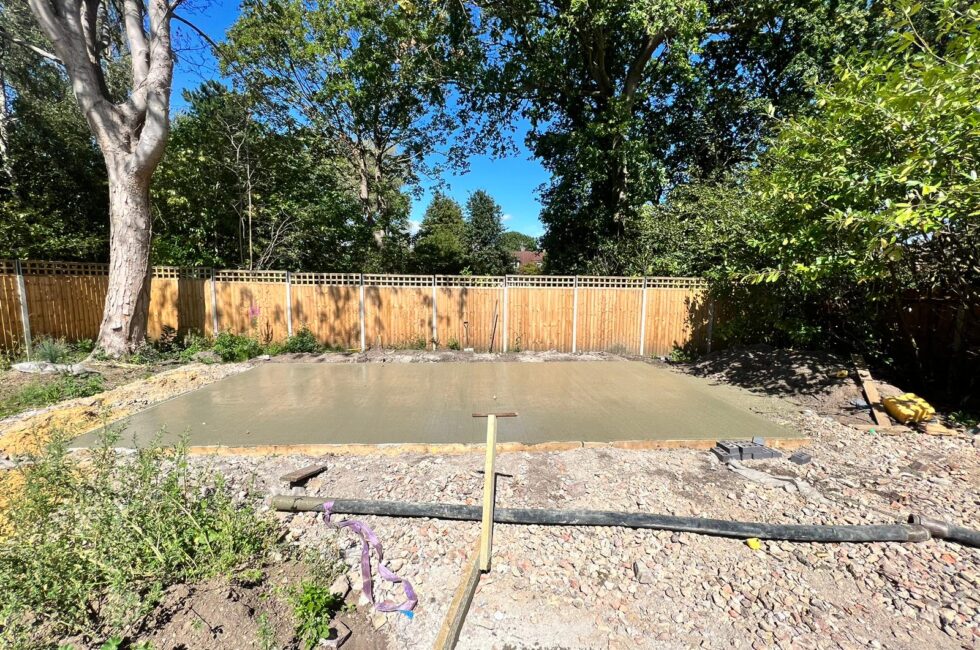- What is the best base for a garden room?
- What is the cheapest base for a garden room?
- Do garden rooms need a concrete base?
- What is the alternative to a concrete slab for a garden room?
- How deep should a concrete slab be for a garden room?
Does a garden room need a concrete base?
Whether a garden room requires a concrete base depends on various factors, including the ground type, size and weight of the structure and the intended use of the space. While a concrete base offers stability and durability, it might not always be necessary. Concrete bases are not the greenest of choices and are a more expensive choice. Other options include concrete piles, ground screws and concrete pads. Smaller garden rooms, summer houses or log cabins might suffice with alternative foundations like paving slabs or plastic grid systems. However, for larger or permanent structures, especially those intended for year-round occupancy, a concrete base, concrete piles, concrete pad or ground screws are often recommended to ensure structural integrity and longevity, providing a solid foundation to support the weight of the garden room and resist ground movement. Consulting with a local garden room company can provide specific guidance tailored to your project's requirements and local regulations. It is worth noting that a garden room over 30m2 will be subject to building regulations and will have the foundations designed specifically according to the soil type. So let's look at the different options and the pros and cons of each as well as the cost.
Concrete raft with steel cages and bars. Insulation, screed and masonry plinth.
Garden Room Foundation Types: Concrete bases vs Ground Screws vs Concrete Piles vs Plastic grid System: The pros and cons of each
Concrete Raft
Pros:- Solid Foundation: Provides a robust base, ideal for garden room gyms or areas with heavy equipment and activity
- Prevents Nesting: Eliminates gaps between the garden room and ground, deterring small animals and rodents from nesting
- Weed Control: Stops weeds from growing underneath the room
- Cost: Higher price point, approximately £70 per square meter, not including labour costs. Additional charges possible for soil excavation
- Environmental Impact: Less sustainable compared to other foundation methods
- Tree Roots: Risks damaging tree roots and may not be suitable for all soil conditions
- Installation Time: Takes several days to complete the installation and setting process
- Rot Prevention: Timber in contact with concrete is susceptible to rot, requiring preventive treatments.
Ground Screws
Pros:- Quick Installation: Typically completed within a morning
- No Digging Required: Eliminates the need for excavation work
- Immediate Construction: Allows for construction to start immediately after installation
- Durability and Eco-Friendliness: More durable and environmentally friendly than concrete
- Adaptability: Ideal for sloped or irregular terrains, avoiding damage to tree roots
- Moisture Protection: Raises timber above moist surfaces, reducing decay risk
- Cost: Potentially more expensive than concrete foundations
- Additional Measures: May require steps or decking to address gaps on uneven terrain
- Coordination Needed: Might need coordination with subcontractors
- Aesthetic Issues: Large screw heads and central placement may necessitate additional decking to conceal ground screws
- Pest Risk: Gaps could allow pests to enter
Concrete Pile Foundations
Pros:- Eco-Friendly: Reduces concrete use by over 90% compared to conventional slabs
- Swift Installation: Typically completed within a morning with minimal disruption and no heavy excavation
- Stability: Distributes weight evenly across several points for enhanced stability
- Versatile: Effective on various ground conditions, including slopes and uneven landscapes
- Tree Root Safety: Does not harm tree roots
- Moisture Protection: Elevates the structure above moist ground, reducing rot risk
- Lightweight: Easy to transport, suitable for locations with limited access
- Gap Issues: Uneven terrain can create gaps between the ground and the garden room, requiring solutions that add to the cost
- Slope Limitations: Not recommended for significantly sloped areas
Plastic Grid System (ProBase)
Pros:- Cost-Effective: More affordable than traditional concrete foundations
- Recyclable and Low Maintenance: Made from recycled plastic, lightweight, and requires no maintenance
- Easy Installation: Simple and efficient to install
- Air Circulation: Enhances air circulation, aiding timber drying
- Drainage: Ensures excellent drainage
- Ground Condition Dependency: Effectiveness influenced by underlying terrain; may shift if ground changes
- Design Limitations: Initially designed for lighter constructions
- Moisture Risk: Higher risk of moisture penetration
- Pest Risk: Gravel can deter larger pests, but smaller insects might enter
- Stability: Susceptible to shifting due to its less rigid material composition
EasyPad (Concrete Pads)
Pros:- Dry Timber: Raises timber above the ground for dryness and proper aeration
- Lightweight: Easy to transport to locations with limited access
- Adjustability: Offers up to 150mm of adjustability for precise on-site levelling
- Eco-Friendly: Cuts down concrete usage by 98% compared to conventional bases
- Simple Installation: No specialized skills or tools needed for installation
- Prolonged Installation: May be prolonged and unsuitable for extremely uneven landscapes
- Ground Suitability: Not ideal for very soggy or soft ground
- Excavation Needs: Additional excavation for fitting pads can increase costs unless the soil can be reused in the garden
How deep should a concrete slab be for a garden room?
A concrete raft should be a minimum of 150mm thick (C35) with A142 or similar mesh reinforcement. FAQs & Helpful Pages- How much does a garden room cost?
- What is the best base for a garden room?
- Do garden rooms need planning permission?
- Design a 3D garden room for free and get an instant price
- The pros and cons of adding a sedum roof
- Is it cheaper to buy or build a garden room?
- Can you sleep in a garden room?
- Go to the Planning Portal to read more on Building Regulations
- Go to the Planning Portal to find out more about Planning Permission and find your Local Authority

